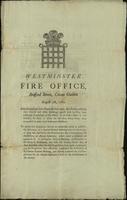All Books and Texts
Pages
-

-
Proposals, being an abstract of the settlement of the Westminster contributionship for insuring houses from loss by fire
-
Regulations approved by the Westminster Fire Office for annual insurance, a part of the constitution of the society., Docket title., "Westminster Fire Office, Bedford Street, Covent Garden, August 1st, 1782"--P. 1., Place of publication from the English Short Title Catalogue., ESTC 155481., Original: 45 x 27 cm folded to 28 x 11 cm (folio).
-

-
Provost's apology
-
Issued: 1838?, Title from caption., Account, in verse, of the Snowball Riot at the University of Edinburgh, January 11-12, 1838., Imprint data from NUC pre-1956 cited below.
-

-
Robert Devoy
-
Published in 1920?, Book provided by University of Missouri -- Columbia
-

-
Rodeheaver Chorus Collection
-
Cast thy burden upon the Lord -- Awakening chorus -- Glorious is thy name -- Onward, Christian soldiers -- Crown him -- Across the sea of life -- Make bare thy arm -- Mighty Jehovah -- Sing unto the Lord -- All hail the King -- The house that stood the storm -- Amazing love -- The hill, the cross, the crown -- We praise thee, O King -- We worship before thee -- Sunset -- Where would I be -- Great is Jehovah -- Praise ye, Jehovah -- Praise ye -- The chapel -- Glorious conqueror -- His love is like a flower -- O that I had wings -- Prince of nations! -- Great is the Lord -- Over the stars -- When early tides were flowing -- Angel of peace -- America for me -- Hear our prayer -- Song of the free -- Song of the triton -- Memoria -- Praise him forevermore -- Gracious Father -- Proclaim the tidings -- He, watching over Israel -- Sweet and low -- Halleluiah chorus -- The heavens are telling.
-

-
Russkīĭ v︠i︡estnik : [tables of contents]
-
You will find here copies of the tables of contents and related pages from the Russkīĭ v︠i︡estnik volumes held by the Ellis Library at the University of Missouri--Columbia. Most of the pages are annotated to indicate whether the pages were from the front, middle, or back of the volumes. Our MERLIN catalog record contains information on the location of the set: http://merlin.mobius.umsystem.edu/record=b2800018.
-

-
Sacred Chimes
-
by John C.F. Kyger and A. Bunyan Little., 260 hymns with music., Includes indexes., a book of new and old hymns and tunes. For use in church services, revival meetings, Sunday schools, young peoples societies, singing schools and conventions
-

-
Savitar - The MU Yearbook
-
The Savitar is the University of Missouri yearbook, which began publication in 1894 and continued as a print publication through 2005. As the University yearbook, the Savitar offers photographs of administrators, faculty, and students, arranged by class, organization, and extracurricular activity. Other photographs include important campus events, such as athletic contests, parades, convocations, and commencements.
The name Savitar originates from the Sun-god of Rig-Veda, in Hindu mythology. Its root, su, means to dry or stimulate. Savitar and its alternate, Surya, denotes splendor of the luminary and irresistible energy - he is the god who sees all things and notes all the good and evil deeds of men. Nothing can withstand his will and age cannot touch him. Other definitions of the Sanskrit word Savitar include: (1) the sun, worshipped as the god of life and represented as drawn in a car of gold; (2) sometimes shown as a woman, Savatari, who sacrificed herself to save her husband who was trapped in the underworld; and (3) an important god, the sun in its life-giving aspect; (4) used for the Sun God from Vedic mythology; (5) quickener, impeiler, or enlivener.
As for the choosing of the name Savitar for the University yearbook, research shows that the aesthetic reasons for selection of the name by University students of 1894 were perhaps tempered by more prosaic ones. Among other things, the editors liked the size and sound of the word. The student editors probably got their idea for the title from Professor James Shannon Blackwell, professor of Semitic and modern languages at the University from 1886 to 1897, who was known as a student of Sanskrit.
Note: The collection also contains the Index, the 1891 yearbook produced by the M.S.U. Athletic Association.
-

-
Secret and Lily Hart
-
On t.p.: The secret and Lily Hart, two tales by Lord Charles Willsby, Verdopolis, 1833., Manuscript signed at the end : Haworth, 1833, Charlotte Brontë., Presented to the University of Missouri Ellis Library by U.S. Senator W.S. Symington on May 9, 1975, among the papers of his wife, E.W. Symington.
Pages
